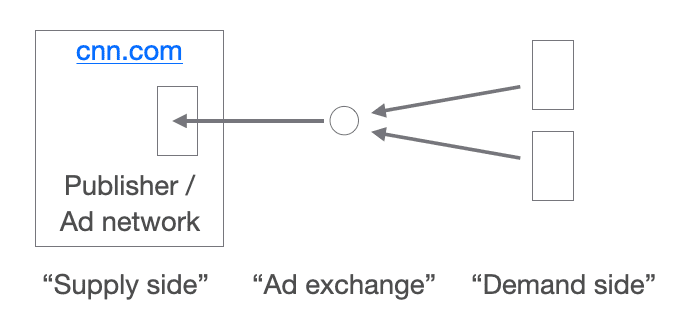Digital advertising
From buying space, to buying audiences
Most digital advertising works in a similar way
- Opportunity to show ad to an individual visiting a site
- Many brands want this opportunity
- Split-second auction to decide which ad gets shown

- Brands which bid more are more likely to be shown, but it’s not guaranteed. Platforms like Google want to satisfy their audience, and give strong weight to the relevance of a message
- “Demand side platforms”, “supply side platforms” and publishers can be separate companies, or, in the case of the tech giants, be integrated under one roof
Each format & platform has its own special power
Formats
Paid Search – Rich & timely intent data
Display – Wide range of websites
Video – Immersive storytelling
Examples of major platforms
Google – Precision targeting & integration
Facebook – Big audience
Amazon – Direct link to purchase
MediaMath – Aggregate other audiences
There are many ways to target an audience. It helps to have a clear view of who you are looking for
Understand customers
- Talk to your customers to understand who they are, and how they might respond to your message
- Try to get the simplest possible definition of what makes a person a suitable prospect for your brand
Examples of ways to target
- Geographic location; time of day
- Context – e.g website the ad appears on
- Demographics – Age, gender, language
- Retargeting – e.g. previous site visitors
- Attitudes as revealed by past behaviour, e.g. what they searched for
Use your own data
- Privacy restrictions make it harder to buy “3rd party” targeting data
- If your audience is narrow (e.g. visitors to your website), you need to collect this data yourself (“1st party”)
- If your audience is broad, then having your own data is less important
Consider personalising ads and landing pages
- Examples of personalisation are retargeting a customer with the product they last viewed on your website, or including a user’s search term in your ad (“Dynamic Keyword Insertion”)
- Personalisation works best at the bottom of the funnel, where you can use conversion data to track it

The approach to evaluation depends on where you are in the funnel
Conversion advertising (bottom of funnel)
- This type of advertising is easiest to evaluate
- While other metrics can be misleading (e.g. wrong people sign up to newsletter), conversion to purchase is always good
- With conversion advertising you can use AI optimisation, because conversions will keep the AI on track
Brand advertising (top of funnel)
- This type of advertising is almost impossible to evaluate directly, especially as part of a complex campaign
- Instead you need to test that the message is compelling and that it reaches the audience
- It’s difficult to audit delivery. This often comes down to trust in the vendor
Multi-step advertising (middle of funnel)
- Most conversions don’t happen on the first visit to your site
- You can use attribution modelling, but you need to keep things stable long enough to gather enough data
- If your conversions are not sales (e.g. test drives) you need to check the conversion rate of each cohort through to sales
All advertising is going digital (“programmatic”)